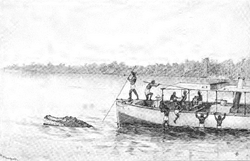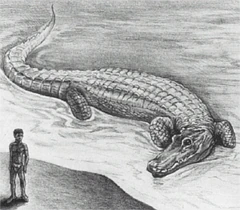| ||||||||||||||
The mahamba, or simply giant crocodile, is a cryptid crocodile reported from the Congo, described as an enormous animal in excess of 40', where the Nile crocodile (Crocodylus niloticus) is not recognised as growing longer than 20'.[1][2]
Description[]
According to Roy P. Mackal's informants, the mahamba resembles a regular crocodile, but is much longer (between 40' and 50' in some sightings, more than 50' in others). Like a crocodile, it lays eggs and eats flesh, including humans, and is also said to dig long tunnels, 50 to 1000 meters long, in the earth, leading to caverns in which it sleeps. Mackal's informants "insisted that the Mahambas were not just outsized specimens of the ordinary variety," and all agreed that the mahamba was a crocodile as opposed to a nguma-monene or a mokele-mbembe.[2]
Sightings[]
circa late 1880's[]
John Reinhardt Werner, an engineer in the service of the Congo Free State, had several encounters with enormous crocodiles - which he suggested were rather common - on the Congo, and described two in detail:[3]
- "On a low sand-spit, projecting beyond the grasses, may sometimes be seen a monster crocodile, perhaps upwards of fifty feet long; at any rate, I have seen several considerably longer than the little A.I.A. [the government steamer where Werner worked] and she measures forty-two feet."
- "On one occasion I had landed on a large sand-bank to shoot ducks. Having bagged one, and seeing that the rest had alighted beyond a low ridge of sand, I stooped down and crawled along behind the ridge till I thought I was within range, when I raised my head and looked over. Sure enough there were the ducks, not fifty yards from me, while half-way between me and them lay the biggest crocodile I had yet seen. Comparing him with the A.I.A. which lay in deep water some 300 yards off, I reckoned him to be quite fifty feet long; while the centre of the saw-like ridge on the top of his back must have been about four feet above the sand on which his belly rested. Having only a shotgun with me, I had, on first seeing him, sent a native boy who was with me for my rifle, and made the foregoing observations while waiting for his return. The crocodile, meantime, took no notice of me — either because he was asleep, or because I was out of his sight, being, to use a nautical term, on his starboard quarter — while taking care to keep well out of range of his huge tail. As the boy was a long time coming, I considered it advisable to get a little further off, and in so doing alarmed the ducks, which flew away to another bank. As we were quite out of meat on board, this sight so wrought upon my feelings that, forgetting all about the crocodile, I took a snap shot after the ducks, which I missed, but so frightened the huge saurian that he made off for the water, scattering the sand far and wide with a sweep of his tail."
1888[]

The A.I.A. run aground on a giant crocodile, from a sketch by Werner.
Werner's second encounter took place in early 1888. Whilst travelling on the river, the A.I.A.:[3]
- "suddenly brought up on a sand-bank, with only three feet of water. The engines were at once stopped, but the steamer's bow was embedded in the sand, which seemed to heave up and down under us, and the water was strangely disturbed. I was looking for the cause of this unusual commotion (which I should have set down as being caused by our running into a hippo, had the river been deeper at that spot, but there was not enough water to cover one), when I saw an enormous crocodile — longer, I am certain, than the A.I.A., and therefore over forty feet — rush across the bank and tumble into the deep water beyond. I never before saw a large crocodile move so quickly, and I had no time to get a shot at him. He must have heard us coming, and been trying to make for the deep water on our side of the bank, when we ran into him and jammed him into the sand. We struck him while moving at the rate of four miles an hour, but during the short time he was in view, I could not see that he bore any marks of the collision."
Notes and references[]
- ↑ Eberhart, George M. (2002) Mysterious Creatures: A Guide to Cryptozoology, ABC-CLIO, Inc., ISBN 1576072835
- ↑ 2.0 2.1 Mackal, Roy P. (1987) A Living Dinosaur? In Search of Mokele-Mbembe, Brill, ISBN 978-9004085435
- ↑ 3.0 3.1 Werner, J. R. (1889) A Visit to Stanley's Rearguard at Major Barttelot's Camp on the Aruhwimi

